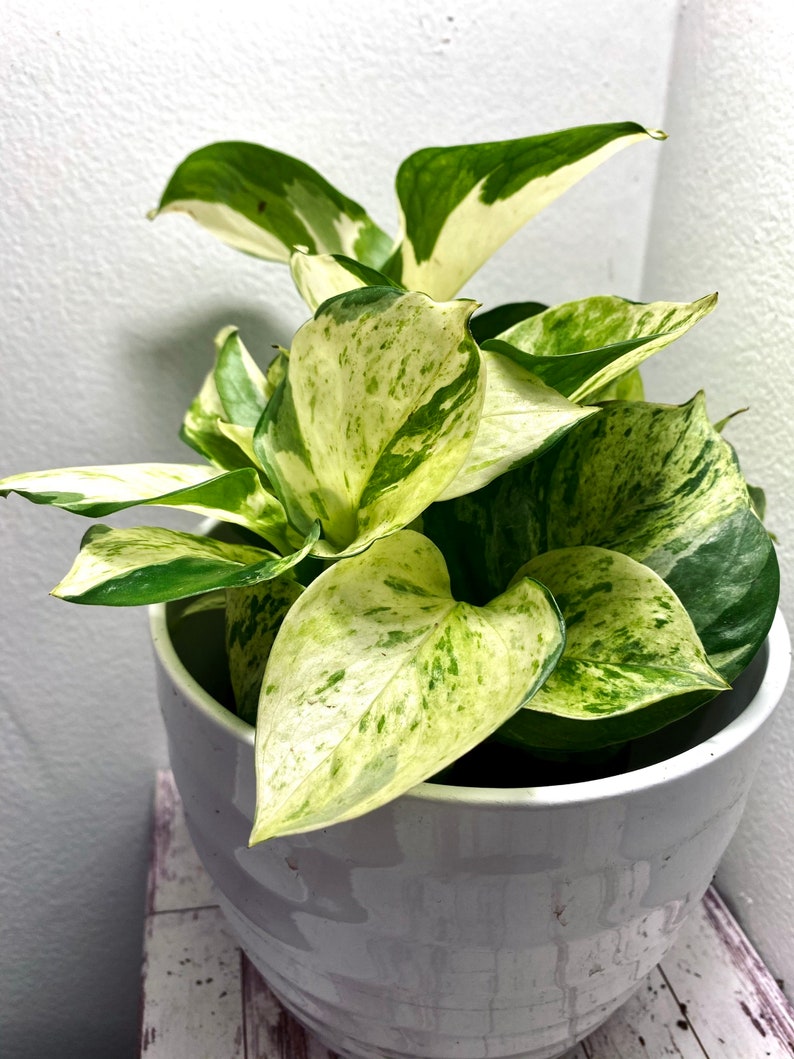Considered one of the most beautiful and captivating of pothos varieties, the Manjula Pothos is one of the more stunning houseplants to care for.
Marbled, patches, swirls, blotches, this pothos offers a unique and stunning variegation of creamy white.
This guide will cover how to care for the manjula pothos plant.
Manjula Pothos Plant Overview
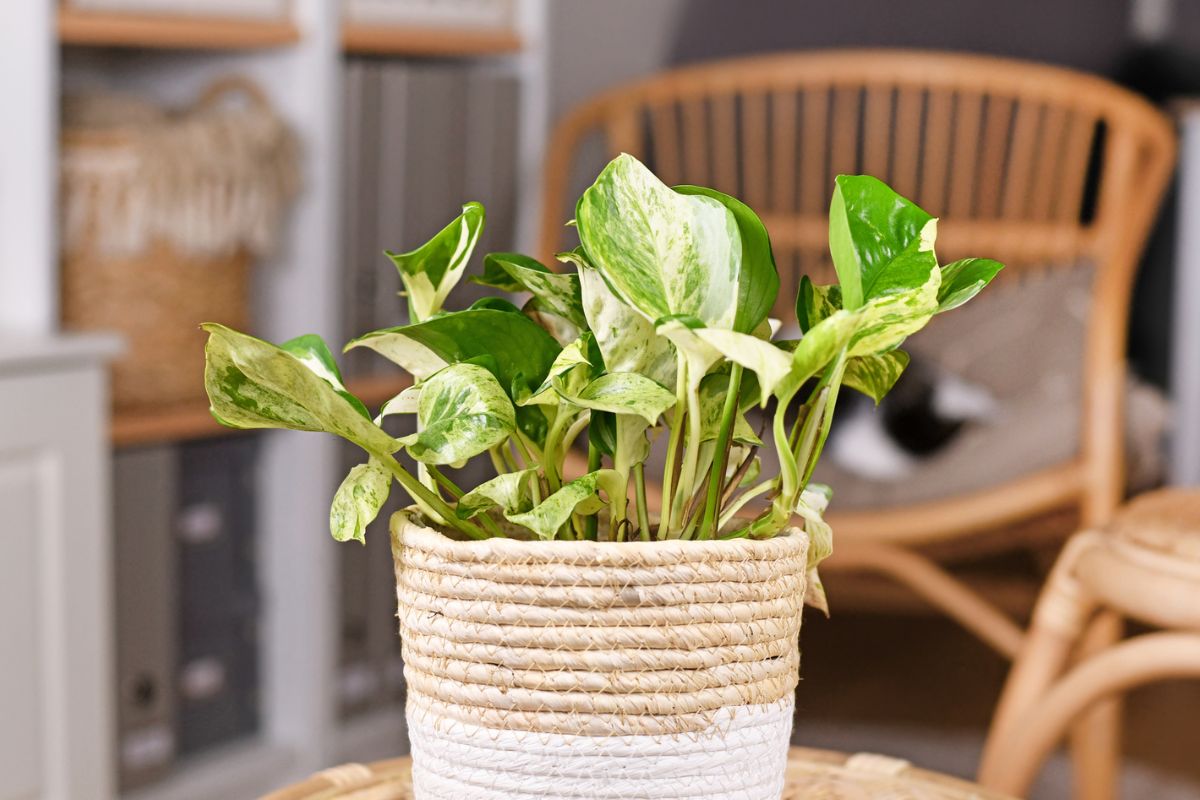
The manjula pothos is botanically known as the Epipremnum aureum Manjula or Happy Leaf Pothos. This cultivar is patented (Hansoti14) and calls India home having been developed by Hansoti.
It features a mixture of heart-shaped, dark and light green variegated leaves with dramatic white and gold (yellow) streaks or swirls.
While most pothos cultivars are known to be fast growers, the manjula pothos is an exception and grows slowly. It grows as a mound, meaning that it will grow in a horizontal and vertical direction, providing fuller, bushier growth.
In fact, it appears to be less vining than other pothos plants with the distance between leaf nodes being shorter as well. The foliage also appears wavy as opposed to the more traditional flat laying leaves of other varieties
The manjula does still vine and looks lovely as a vining plant on either a pole or trellis, or when flowing down from a shelf or hanging planter. It also makes for a great terrarium plant due to its slow growth.
Manjula Pothos Plant Care Guide
Soil for the Manjula Pothos
For the manjula pothos, you need a loamy soil bed that retains moisture, but drains well. The preferred pH level for your manjula pothos is between 6.1 and 6.5.
You can mix your own potting soil by blending two parts of peat moss with one-part organic compost or one part perlite.
If you want to buy a commercial potting mix, the African Violet potting soil mix is a good option.
Temperature for the Manjula Pothos
Average temperatures ranging between 50°and 95°F is best for the manjula pothos and maintaining its health.
However, they can manage temperatures as low as 45°F and as high as 100°F for short periods of time. If the temperature is high, be sure it is receiving shade.
Light for the Manjula Pothos
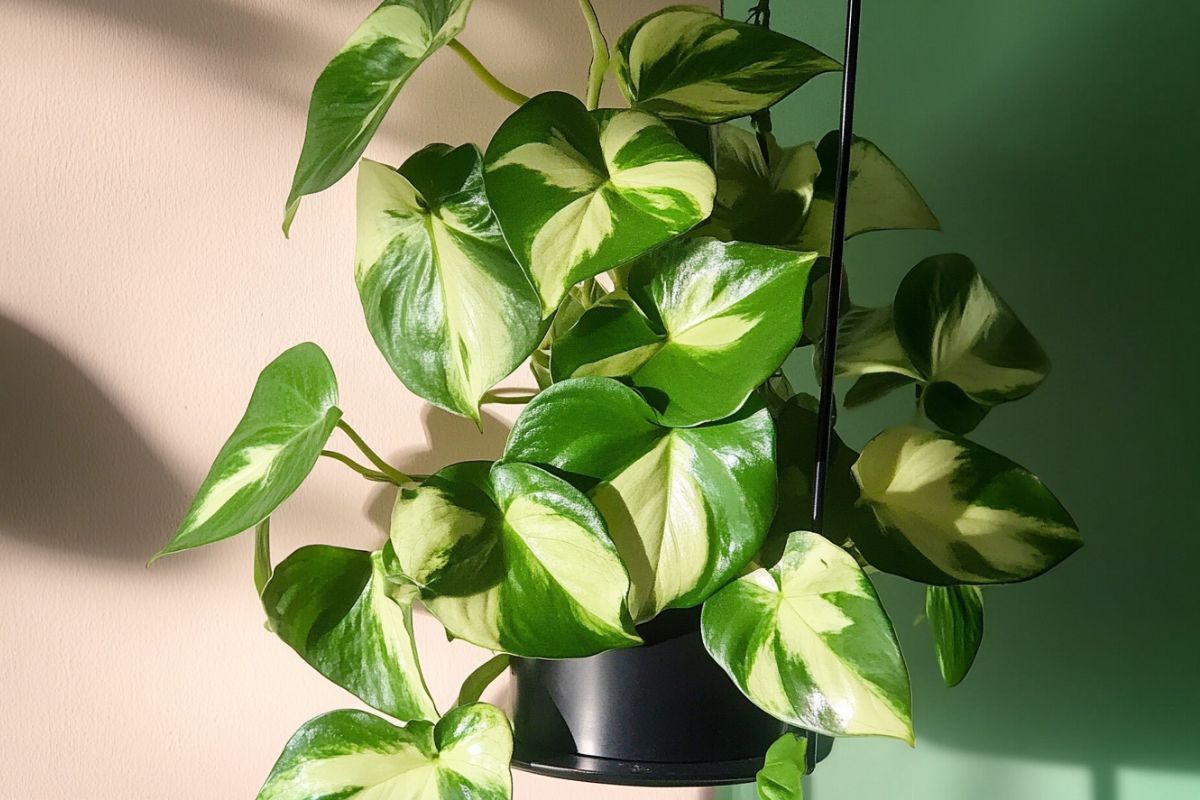
Like most pothos plants, the manjula can adapt and survive in just about any lighting. Nonetheless, bright indirect light is always preferable to direct sunlight exposure.
Even though these plants enjoy warm temperatures, direct sunlight will scorch foliage.
This particular pothos will require bright indirect light due to the amount of white in foliage to be able to photosynthesize and nourish itself. So, the brighter the light you can provide the better.
In low light conditions, the variegated foliage can lose some of its characteristic white leaves. If your home does not have access to bright light, you can set up a grow light to help it indoors.
Water for the Manjula Pothos
Overwatering can be lethal to houseplants. To protect the health growth of your manjula pothos, make sure that it is never left sitting in water or that the soil bed becomes soggy and waterlogged.
Choosing a pot with excellent drainage holes will help keep your plant free of root rot. This pothos is not drought tolerant, so it will require watering on a regular schedule.
Water the manjula pothos evenly to keep the soil moist for healthy growth. Always test your soil bed by sticking your finger in the soil a couple of inches to feel if it’s still moist or dry.
Should you place your manjula pothos in a terrarium, make sure to add a drainage layer.
WHen it comes to the type of water you use, try to avoid using tap water because it can contain chlorine, fluoride or other minerals that aren’t good for plant growth.
Humidity for the Manjula Pothos
The manjula pothos variety loves humidity. It prefers a 60% to 90% humidity level. With a higher humidity level, aerial roots will develop.
A steamy bathroom with bright indirect light will make for a happy and thriving plant. If you need to increase humidity, try grouping the manjula with other plants or placing it on top of a pebble tray.
As the water in the pebble tray evaporates it increases humidity around the plant.
A humidifier is an easyt way to increase humidity levels.
Fertilizer for the Manjula Pothos
The manjula pothos is not a huge eater, but will need to be fertilized during its growing season in the spring and summer months will help it grow.
Fertilize bi-weekly with a liquid fertilizer for houseplants that is diluted to half of its strength. Do not fertilize in autumn or winter.
Pruning the Manjula Pothos
To maintain a fuller, round shape, prune your manjula pothos regularly or pinch the stem tips.
With longer trimming pieces, you can use those to propagate the manjula pothos.
Propagating the Manjula Pothos
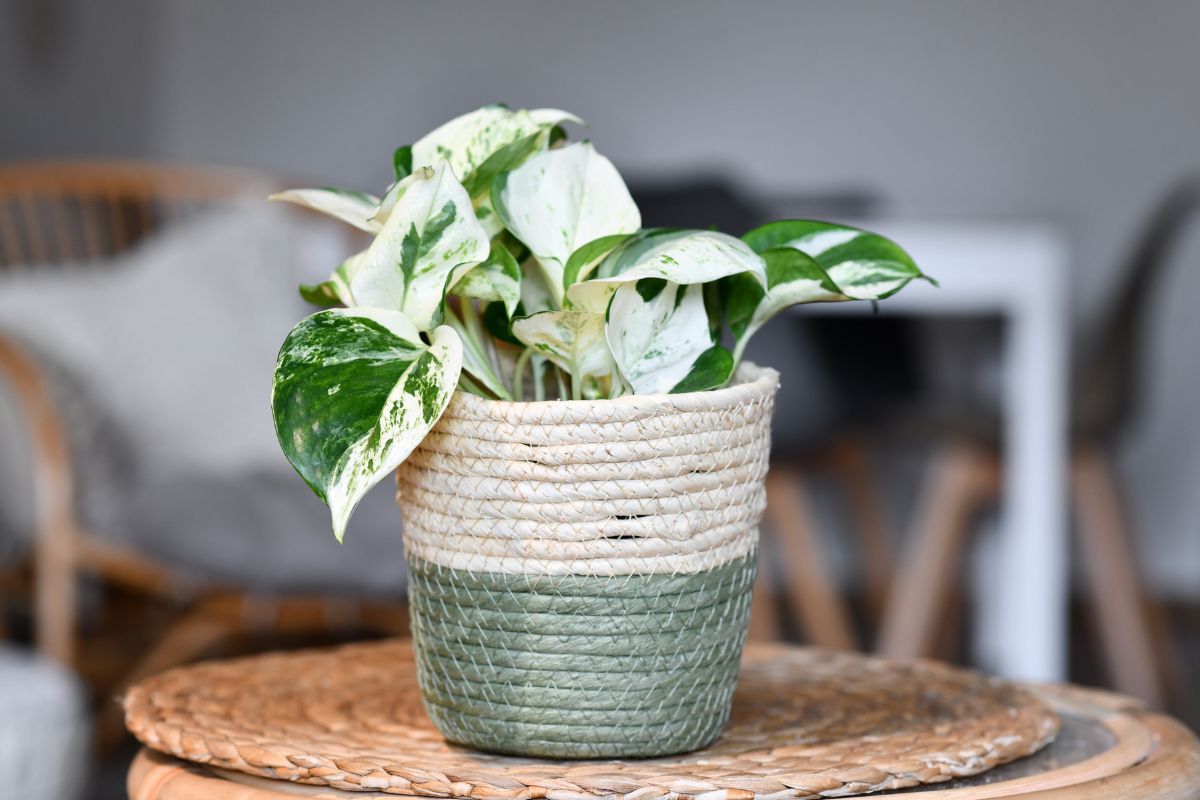
The manjula pothos can easily be propagated with stem cuttings.
Take a stem cutting by snipping one below the leaf node. Place it in a vase or jar with water and wait for the roots to form.
You may have to wait as much as 20 days in warmer weather and perhaps double this in the winter for new roots.
When the roots form, you can transplant them into fresh potting soil mix.
Repotting the Manjula Pothos
Spring is the best time to repot your manjula, but this should only be done if the plant has outgrown its current pot, which can take one to two years to happen.
As soon as you notice roots growing out of the drainage holes or breaking the soil surface, you’ll know it’s time to repot.
Get a container that is approximately two inches larger than the current pot. Add some soil to the bottom. Place the plant inside and then fill in the pot with soil.
Manjula Pothos Toxicity and Pets
The manjula pothos leaves are toxic if ingested. If you suspect your animal has eaten the leaves, do not attempt to treat them yourself. Instead, take the pet to a vet for treatment. If your pet gets hold of this potted plant, call a veterinarian immediately.
Poisoning symptoms can include nausea, vomiting and abdominal pains. Also, be on the lookout for drooling, excessive salivation, and sores in the mouth.
It’s best to keep the manjula pothos and its leaves out of the reach of your pets and any small children.
Manjula Pothos Problems and Pests
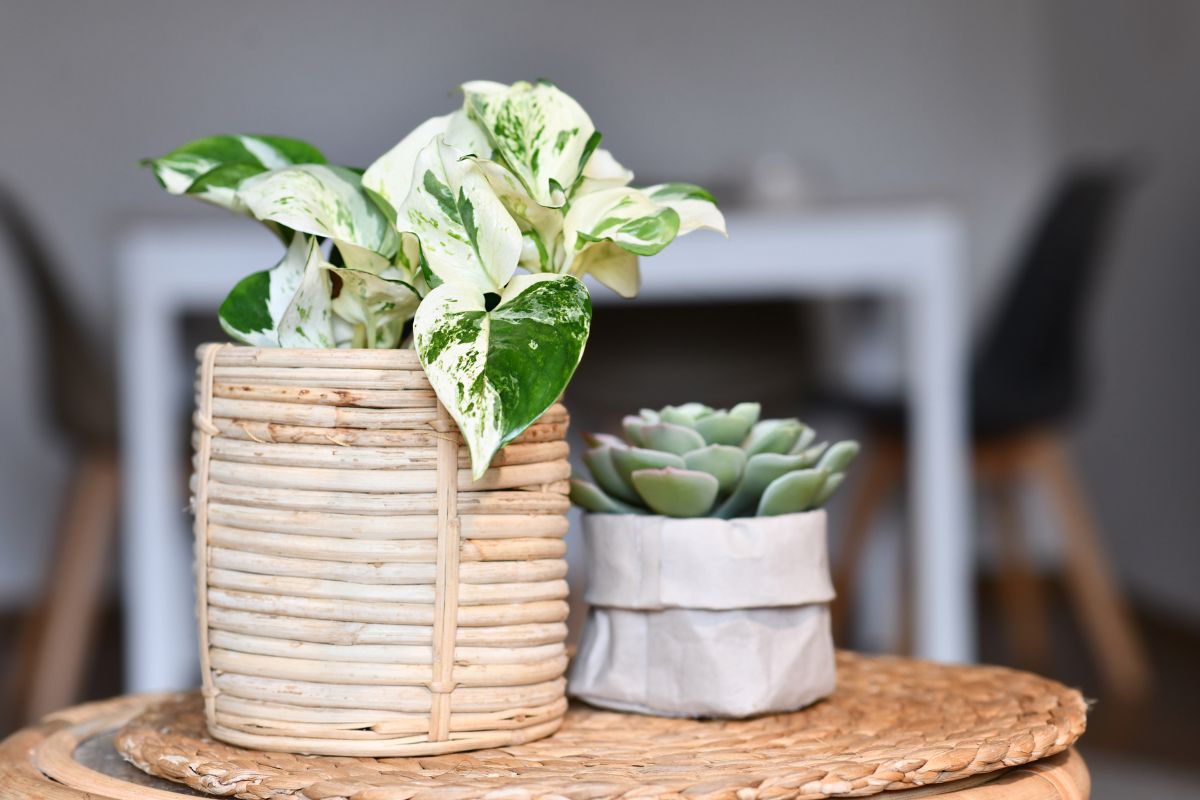
When your manjula begins to turn green, you have a light problem. The manjula is not getting sufficient light for photosynthesis. You can either relocate it to a brighter location or try a growing light.
One maintenance tip is to clean the pothos foliage every two to three weeks with a damp cloth to remove dust and dirt. This will aid the plant in its process of photosynthesis.
Excessive watering can lead to root rot, leaf spot, botrytis or other fungal infections.
If you see yellow leaves, it’s a sign your plant may already have root rot. Check to see if the plant is draining correctly. Do not allow it to sit in soggy soil. Let the soil bed dry somewhat between one watering and the next.
Pest infestations for a manjula pothos will usually come from common household pests like spider mites, scale insects, or mealybugs.
Spider mites may appear as black specks on foliage, scale insects will look like a waxy substance usually found on stems, while mealybugs leave white cotton-like deposits on leaves.
You can remove scales and mealybugs manually and then treat your plant with an insecticidal soap or neem oil. In the case of spider mites, a good shower for your plant will remove the mites and then proceed with neem oil or insecticidal soap treatment for prevention.
Manjula Pothos Care Final Thoughts
The manjula pothos is a very easy plant to grow. It requires little attention from you and is fairly forgiving when it comes to pests and diseases.
For other varieties of pothos plants and houseplants, check these out:
Manjula Pothos FAQs
What is a Manjula pothos?
The Manjula pothos is a patented variety of the pothos family of plants. They feature heart-shaped, variegated leaves with white, cream, silver, and light green. Its wavy leaves are each unique and they’re lovely plants to display at home and the office.
Is Manjula pothos rare?
Yes, the Manjula pothos can be pretty rare as they’re not easy to find. These beautiful plants are loved for their mostly cream and white variegation on the leaves, but not as available in local nurseries and online.
Why is Manjula pothos expensive?
The Manjula pothos plant is also very expensive due to the high demand and limited supply. They do not grow fast, so the supply isn’t always available like fast-growing plants are. The Manjula plant is known to be one of the best-looking indoor plants available today though. You may be able to find them cheaper at local nurseries and garden stores depending on where you live.
Do Manjula pothos grow fast?
No, the Manjula pothos are slow growers because they contain less chlorophyll in the leaves due to the variegation in the leaves. That means they don’t have the food available to grow faster.

